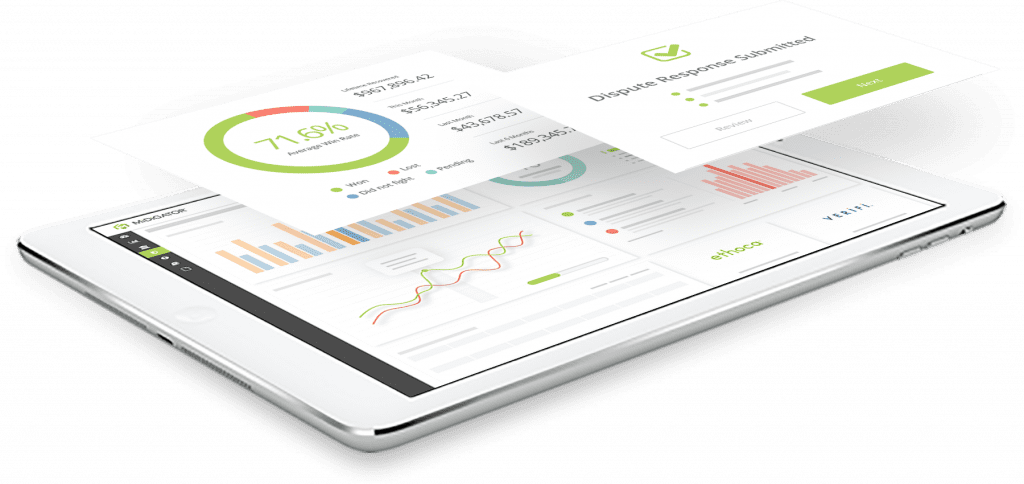Chargeback Facts vs. Fiction: 15 Things You Shouldn’t Believe
- July 8, 2019
- 8 minutes
Chargebacks can be confusing and complex. As a result, it is often difficult to distinguish actual chargeback facts from myths, legends, or assumptions.
But even though it’s challenging, it’s necessary to recognize the difference between truths that can help your business and falsehoods that can seriously damage it.
To help increase clarity, we’ve outlined the 15 most common payment industry myths — and the chargeback facts you should believe instead.
A Word of Warning
The following information might seriously challenge some of your beliefs about chargeback management.
If you discover a myth is negatively impacting your business and you want to make adjustments to your chargeback management strategy, Midigator® can help. Schedule a time to meet with our team, and discuss the best options for your business.
The aim of this article is to decrease confusion, not increase it. So please reach out if you have doubts or questions about anything you read here.
My terms and conditions clearly state that all sales are final, so customers can’t file chargebacks.
If all sales are final, you’ll probably receive more chargebacks, not less. If customers know they can’t get a refund from your customer service team, the only option they have is to request a chargeback from the credit card company.
Issuing banks don’t spend much time determining whether or not chargeback requests valid. No one at the bank is going to look for and review your terms and conditions. The bank will simply dispute a charge and wait to see what you have to say about it.
Clearly defined terms and conditions can help you fight chargebacks, but they won’t stop the disputes from happening.
I sent an authorization request, and it was approved. I won’t get a chargeback.
An ‘approved’ authorization response simply means the bank thinks it’s OK to complete the transaction — the account is in good standing, there are enough funds or available credit to cover the transaction, and the card hasn’t been reported lost or stolen.
Just because the bank has approved the transaction doesn’t mean the cardholder has. The authorization process doesn’t check for potential fraud.
As long as my chargeback count is low, my ratio can be as high as I want.
The card brands have chargeback monitoring programs (learn about Mastercard’s here and Visa’s here). Merchants are enrolled in these programs if they breach both the card network’s chargeback count limit and chargeback-to-transaction ratio threshold.
But those are the card network regulations. Your acquirer has different regulations and thresholds.
Even if your chargeback count is below the limit, an extremely high ratio can lead to account closure.
I have a fraud tool. That’s all the chargeback management help I need.
Using a tool to detect and block potentially fraudulent orders is a great idea. It can really help you reduce your risk exposure.
But it won’t prevent all types of chargebacks.
A recent study found that 77.25% of fraud chargebacks were actually friendly fraud. So a fraud tool, which can’t prevent unscrupulous customer behavior or misunderstandings, wouldn’t offer sufficient protection against the vast majority of your disputes.
And, chargeback prevention is only one piece of the chargeback management puzzle. You also have to fight chargebacks — which a fraud tool can’t do.
You need a multi-layer chargeback management strategy that includes much more than just a pre-sale fraud detection tool.
I found a service provider with a win rate guarantee. That means I’ll have the absolute best results possible.
There are a couple of different types of guarantees on the market today. They are all different but have one thing in common: complicated restrictions on what is and isn’t covered.
A win rate guarantee is tempting, but unfortunately, it probably doesn’t mean what you think it does.
Customized chargeback responses, automation, and intelligent fight rules yield an average win rate of 85%, but the best a guarantee can offer is 40%.
I had a bad marketing source. These chargebacks aren’t my fault and won’t count against me.
Fraud causes a trickle-down effect. The unsuspecting cardholder is the first victim. When the cardholder requests a chargeback, you become the second victim.
Even if you weren’t the one committing fraud, you’re still responsible for the resulting chargebacks. You’re expected to be aware of and proactively prevent all potential threats to your business. That includes avoiding bad marketing sources and partners.
I won’t be getting any more chargebacks. My processor closed my account.
It might seem like a closed merchant account would resolve the issue of chargebacks, but that’s unfortunately not the case.
Most chargebacks need to be filed within 120 days of the transaction, but some time limits extend up to 540 days after you’ve processed the purchase. This means you could receive chargebacks for months or even years after your account has been closed.
And, no matter when the chargeback is issued, whether your account is open or closed, you are responsible for covering the amount of the chargeback and any fees. Financial liability doesn’t shift to your processor.
The more chargebacks I fight, the fewer chargebacks I’ll receive.
Some industry “experts” claim that the more chargebacks you respond to, the better your reputation will be with your customers’ banks.
You’ll supposedly become known as a fighter. To avoid the administrative hassle of processing each of your chargeback responses (also known as chargeback representments), banks will theoretically put in the extra effort up front to be sure they aren’t sending you any friendly fraud or invalid disputes.
This might be true — but only if you have the volume and prestige of brands like Amazon or Apple.
Large issuing banks have dozens — if not hundreds — of people working in their chargeback processing department. Each one of those employees would have to receive hundreds of responses before there is even a chance that a merchant’s actions would be noticed.
Unfortunately, the average merchant just doesn’t have a high enough concentration of activity per representative at every issuing bank to generate any real prevention results.
The customer is going to contact the bank and explain that the chargeback was a mistake. I don’t have to respond.
Customers will sometimes realize they’ve made a mistake and admit that the chargeback wasn’t necessary. This is great news, but it’s a tricky situation to handle.
It’s highly unlikely that a chargeback can be canceled. The customer would have to act very quickly, and even then, it might still be impossible for the bank to reverse its actions.
It’s nice when customers want to fix their mistakes, but unfortunately, there isn’t much they can do to help. If a chargeback is invalid and you want to recover your revenue, you have to fight via the chargeback dispute process. Send a response to the customer’s bank, just like you would for any other dispute.
If I get a chargeback, all I have to do is refund the order and the bank will cancel the chargeback.
If you refunded the order before you received the chargeback, you can respond and use the refund as compelling evidence.
However, you shouldn’t issue a refund after you’ve received a chargeback. That would credit the cardholder’s account twice — and cause double the revenue loss.
The best way to win a chargeback is to formally send a response to the issuer via your acquirer. Once the bank has filed a chargeback, it usually can’t be canceled.
My acquiring bank doesn’t care if I do or don’t fight. The bank only cares about my ratio.
Your bank cares about risk exposure. Will your business negatively impact theirs?
So yes, your acquiring bank is interested in your ratio because it is a metric that helps monitor risk. But it is just one of many metrics that the bank uses to gauge your overall reputation.
Another metric your acquirer is interested in is the percent of chargebacks you fight. If you aren’t fighting, the bank is going to wonder why. The credibility of your business will be called into question because a legitimate operation would want to collect money that was rightfully theirs.
If I fight chargebacks, my customers will get mad.
There is something really important you need to remember about a chargeback: your customer turned to the bank for help, not you.
So, in the customer’s mind, anything that does or doesn’t happen during the chargeback process is a direct result of the bank’s actions. And the quality of the customer experience is a reflection of the bank.
Since your chargeback responses happen behind the scenes, there is no reason to suspect customers would get angry with you — they probably didn’t even know you were involved!
There are a lot of things that can negatively impact customer lifetime value (CLV), but fortunately, fighting chargebacks isn’t one of them.
When I fight and win a chargeback response, the chargeback comes off my ratio.
This would be so helpful if it was true!
Unfortunately, the card brands (Visa, Mastercard) think that once a chargeback has been triggered, the damage has been done.
There are several benefits of fighting chargebacks, so you should still respond. However, your efforts won’t impact your chargeback-to-transaction ratio.
I’m not allowed to fight Visa’s reason code 10.4.
There was a lot of confusion when Visa Claims Resolution (VCR) took effect. One thing that many people didn’t understand was reason code 10.4 (Fraud, Card Absent Environment). Some industry members thought merchants weren’t allowed to fight these disputes.
But just like any other reason code, merchants are allowed to fight these fraud-related disputes. Visa outlines 25 different compelling evidence options for reason code 10.4. And they recently launched the Visa CE 3.0 initiative to make it even easier for merchants to manager 10.4 disputes.
If you have the correct compelling evidence, you can fight and win.
If I send a pre-arbitration response, I’ll have to pay a really expensive arbitration filing fee.
There are two types of pre-arbitration, and neither automatically trigger the high-priced arbitration process.
This myth came about after Visa launched VCR. The initiative introduced new terms and renamed several common phrases. One update was to use the term ‘pre-arbitration response’ in a new way.
For a certain type of dispute — including the most common dispute, 10.4 – Fraud, Card Absent Environment — ’pre-arbitration response’ now represents what was formerly referred to as a representment or chargeback dispute. It’s the process a merchant uses to fight or respond to a dispute.
When you send a pre-arbitration response, the cardholder’s bank can either accept the response (meaning you win the dispute) or the bank can reject the response by sending a pre-arbitration denial. If a denial is issued, you can accept the dispute or you can ask your bank to file for arbitration on your behalf. If your bank starts this new process, then arbitration fees would come into play.
Want Help Distinguishing Fact from Fiction?
Are you tired of falsehoods and assumptions? Irritated by the time consuming process of digging through complicated rules and expectations? Do you want clarity and insight so you can make the best decisions for your business?
Midigator can help.
At Midigator, we believe the challenges of running a business should be delivering great products or services, not managing payment risk. Let us remove the complexity of chargebacks — including the hard-to-identify myths — so you can get back to running your business.
Contact us today. We’ll make sure you can always tell the chargeback facts from fiction.













